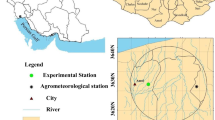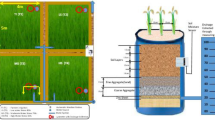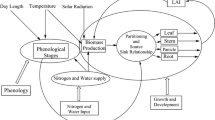Abstract
Water management technologies under projected climate change will play key role in sustainable rice production. Modeling approach was used to assess the impact of climate change on rice production under drip irrigation (DIR) and conventional puddle transplanted (PTR) in subtropical India. The genotype coefficients of CERES-Rice model (cv. Naveen) were determined and tested using experimental data for the years 2012–2014. Close match between the observed and simulated values was recorded during both the years which led to higher d-index (> 0.95) and lower normalized RMSE (RMSEn) values. Under the projected climate change scenarios (RCP 4.5 and RCP 8.5), grain yield reduced over the period 2020–2080, with higher decline in RCP 8.5. Over the period, higher nitrogen (N) use efficiency in DIR led to lower yield reduction over PTR. Among the different adaptation measures, higher fertilizer N dose was able to mitigate negative impact of temperature rise up to 3.3 °C over base period, beyond which grain yield was significantly reduced. Results of the simulations for the different sowing dates stated higher reduction in grain yield with delayed sowing in DIR as well as in PTR for both (RCP 4.5 and 8.5) climate change scenarios. However, early sowing resulted in better crop establishment in DIR leading to better yield compared to PTR in both the climate change scenarios.










Similar content being viewed by others
References
Ahmad, S., Ahmad, A., Ali, H., Hussain, A., Garcia y Garcia, A., Khan, M. A., et al. (2013). Application of the CSM-CERES-Rice model for evaluation of plant density and irrigation management of transplanted rice for an irrigated semiarid environment. Irrigation Science, 31(3), 491–506.
Ahmad, S., Ahmad, A., Soler, C. M. T., Ali, H., Zia-Ul-Haq, M., Anothai, J., et al. (2012). Application of the CSM-CERES-Rice model for evaluation of plant density and nitrogen management of fine transplanted rice for an irrigated semiarid environment. Precision Agriculture, 13(2), 200–218.
Boote, K. J., Jones, J. W., Hoogenboom, G., & Pickering, N. B. (1998). The CROPGRO model for grain legumes. In G. Y. Tsuji, et al. (Eds.), Understanding options for agricultural production (pp. 99–128). Dordrecht: Kluwer Academic Publishers.
Cassman, K. G., Dobermann, A., & Walters, D. T. (2002). Agroecosystems, nitrogen-use efficiency, and nitrogen management. AMBIO: A Journal of the Human Environment, 31(2), 132–140.
Chun-Lin, S. H. I., Zhi-Qing, J. I. N., Zheng, J. C., & Ri-Sheng, T. A. N. G. (2008). Effect of high temperature at meiosis stage on seed-setting rate in rice. Acta Agronomica Sinica, 34(4), 627–631.
De Datta, S. K. (1981). Principles and practices of rice production. Los Baños: International Rice Research Institute.
Dingkuhn, M., De Vries, F. P., De Datta, S. K., & Van Laar, H. H. (1991). Concepts for a new plant type for direct seeded flooded tropical rice. In Direct seeded flooded rice in the tropics. Selected papers International Rice Research Conference (IRRC), Seoul, South Korea, 1990 (pp. 17–38). Manila: IRRI.
Evans, L. T., & De Datta, S. K. (1979). The relation between irradiance and grain yield of irrigated rice in the tropics, as influenced by cultivar, nitrogen fertilizer application and month of planting. Field Crops Research, 2, 1–17.
Fageria, N. K., & Baligar, V. C. (2001). Lowland rice response to nitrogen fertilization. Communications in Soil Science and Plant Analysis, 32(9–10), 1405–1429.
Fageria, N. K., De Morais, O. P., & Dos Santos, A. B. (2010). Nitrogen use efficiency in upland rice genotypes. Journal of Plant Nutrition, 33(11), 1696–1711.
Fitzgerald, M. A., & Resurreccion, A. P. (2009). Maintaining the yield of edible rice in a warming world. Functional Plant Biology, 36(12), 1037–1045.
Ghose, B., Sarker, S., Kpoghomou, M. A., Gao, H., Jun, L., Yin, D., et al. (2013). Self-sufficiency in rice and food security: A South Asian perspective. Agriculture and Food Security, 2(1), 10–16.
Giorgi, F., Jones, C., & Asrar, G. R. (2009). Addressing climate information needs at the regional level: The CORDEX framework. World Meteorological Organization (WMO) Bulletin, 58(3), 175–183.
Hoogenboom, G., Jones, J. W., Wilkens, P. W., Porter, C. H., Boote, K. J., Hunt, L. A., et al. (2015). Decision Support System for Agrotechnology Transfer (DSSAT) Version 4.6 (http://www.DSSAT.net). Prosser, Washington: DSSAT Foundation.
Hunt, L. A., & Boote, K. J. (1998). Data for model operation, calibration, and evaluation. In G. Y. Tsuji, G. Hoogenboom, & P. K. Thornton (Eds.), Understanding options for agricultural production (pp. 9–39). Dordrecht: Kluwer Academic Publishers.
Hurtt, G. C., Chini, L. P., Frolking, S., Betts, R. A., Feddema, J., Fischer, G., et al. (2011). Harmonization of land-use scenarios for the period 1500–2100: 600 years of global gridded annual land-use transitions, wood harvest, and resulting secondary lands. Climatic Change, 109(1–2), 117–161.
Jagadish, S. V. K., Craufurd, P. Q., Shi, W., & Oane, R. (2013). A phenotypic marker for quantifying heat stress impact during microsporogenesis in rice (Oryza sativa L.). Functional Plant Biology, 41(1), 48–55.
Jamieson, P. D., Porter, J. R., & Wilson, D. R. (1991). A test of the computer simulation model ARCWHEAT1 on wheat crops grown in New Zealand. Field Crops Research, 27(4), 337–350.
Jones, J. W., Hoogenboom, G., Porter, C. H., Boote, K. J., Batchelor, W. D., Hunt, L. A., et al. (2003). The DSSAT cropping system model. European Journal of Agronomy, 18(3), 235–265.
Julia, C., & Dingkuhn, M. (2013). Predicting temperature induced sterility of rice spikelets requires simulation of crop-generated microclimate. European Journal of Agronomy, 49, 50–60.
Kadiyala, M. D. M., Jones, J. W., Mylavarapu, R. S., Li, Y. C., & Reddy, M. D. (2015). Identifying irrigation and nitrogen best management practices for aerobic rice–maize cropping system for semi-arid tropics using CERES-rice and maize models. Agricultural Water Management, 149, 23–32.
Kim, H. Y., Lieffering, M., Kobayashi, K., Okada, M., Mitchell, M. W., & Gumpertz, M. (2003). Effects of free-air CO2 enrichment and nitrogen supply on the yield of temperate paddy rice crops. Field Crops Research, 83(3), 261–270.
Krishnan, P., Swain, D. K., Bhaskar, B. C., Nayak, S. K., & Dash, R. N. (2007). Impact of elevated CO2 and temperature on rice yield and methods of adaptation as evaluated by crop simulation studies. Agriculture, Ecosystems & Environment, 122(2), 233–242.
Leeper, E. M. (2010). Monetary science, fiscal alchemy (No. w16510). National Bureau of Economic Research. In Proceedings—Economic Policy Symposium—Jackson Hole, Federal Reserve Bank of Kansas City (pp. 361–434).
Lehmann, N., Finger, R., Klein, T., Calanca, P., & Walter, A. (2013). Adapting crop management practices to climate change: Modeling optimal solutions at the field scale. Agricultural Systems, 117, 55–65.
Lieffering, M., Kim, H. Y., Kobayashi, K., & Okada, M. (2004). The impact of elevated CO2 on the elemental concentrations of field-grown rice grains. Field Crops Research, 88(2), 279–286.
Lobell, D. B., Hammer, G. L., McLean, G., Messina, C., Roberts, M. J., & Schlenker, W. (2013). The critical role of extreme heat for maize production in the United States. Nature Climate Change, 3(5), 497–501.
Long, S. P., & Ort, D. R. (2010). More than taking the heat: Crops and global change. Current Opinion in Plant Biology, 13(3), 241–248.
Masutomi, Y., Takahashi, K., Harasawa, H., & Matsuoka, Y. (2009). Impact assessment of climate change on rice production in Asia in comprehensive consideration of process/parameter uncertainty in general circulation models. Agriculture, Ecosystems & Environment, 131(3), 281–291.
Maytín, C. E., Acevedo, M. F., Jaimez, R., Anderson, R., Harwell, M. A., Robock, A., et al. (1995). Potential effects of global climatic change on the phenology and yield of maize in Venezuela. Climatic Change, 29(2), 189–211.
Mishra, A., Singh, R., Raghuwanshi, N. S., Chatterjee, C., & Froebrich, J. (2013). Spatial variability of climate change impacts on yield of rice and wheat in the Indian Ganga Basin. Science of the Total Environment, 468, S132–S138.
Misselhorn, A., Aggarwal, P., Ericksen, P., Gregory, P., Horn-Phathanothai, L., Ingram, J., et al. (2012). A vision for attaining food security. Current Opinion in Environmental Sustainability, 4(1), 7–17.
Moss, R. H., Edmonds, J. A., Hibbard, K. A., Manning, M. R., Rose, S. K., Van Vuuren, D. P., et al. (2010). The next generation of scenarios for climate change research and assessment. Nature, 463(7282), 747–756.
Mueller, N. D., Gerber, J. S., Johnston, M., Ray, D. K., Ramankutty, N., & Foley, J. A. (2012). Closing yield gaps through nutrient and water management. Nature, 490(7419), 254–257.
Nayak, D. C., Sarkar, D., & Velayutham, M. (2001). Soil series of West Bengal (Vol. 89). Nagpur: National Bureau of Soil Survey and Land Use Planning.
Peng, S. B., Huang, J. L., Sheehy, J. E., Laza, R. C., Visperas, R. M., Zhong, X., et al. (2004). Rice yield decline with higher night temperature from global warming. Proceedings of the National Academy of Sciences of the United States of America, 101(27), 9971–9975.
Prasad, P. V. V., Boote, K. J., & Hartwell, L. A. (2006). Adverse high temperature effects on pollen viability, seed-set, seed yield and harvest index of grain-sorghum [Sorghum bicolor (L.) Moench] are more severe at elevated carbon dioxide due to higher tissue temperatures. Agricultural and Forest Meteorology, 139(3), 237–251.
Rajwade, Y. A., Swain, D. K., Tiwari, K. N., & Bhadoria, P. B. S. (2018). Grain yield, water productivity, and soil nitrogen dynamics in drip irrigated rice under varying nitrogen rates. Agronomy Journal, 110(3), 868–878.
Rajwade, Y. A., Swain, D. K., Tiwari, K. N., Mohanty, U. C., & Goswami, P. (2015). Evaluation of field level adaptation measures under the climate change scenarios in rice based cropping system in India. Environmental Processes, 2(4), 669–687.
Riahi, K., Rao, S., Krey, V., Cho, C., Chirkov, V., Fischer, G., et al. (2011). RCP 8.5—A scenario of comparatively high greenhouse gas emissions. Climatic Change, 109(1–2), 33–57.
Rosenzweig, C. E., Jones, J. W., Hatfield, J., Antle, J., Ruane, A., Boote, K., et al. (2015). Guide for Regional Integrated Assessments: Handbook of Methods and Procedures, Version 5.1. Appendix 1.
Satapathy, S. S., Swain, D. K., & Herath, S. (2014). Field experiments and simulation to evaluate rice cultivar adaptation to elevated carbon dioxide and temperature in sub-tropical India. European Journal of Agronomy, 54, 21–33.
Swain, D. K., Bhaskar, B. C., Krishman, P., Rao, K. S., Nayak, S. K., & Dash, R. N. (2006). Variation in yield, N uptake and N use efficiency of medium and late duration rice varieties. The Journal of Agricultural Science, 144, 69–83.
Teichmann, C., Eggert, B., Elizalde, A., Haensler, A., Jacob, D., Kumar, P., et al. (2013). How does a regional climate model modify the projected climate change signal of the driving GCM: A study over different CORDEX regions using REMO. Atmosphere, 4(2), 214–236.
Thomson, A. M., Calvin, K. V., Smith, S. J., Kyle, G. P., Volke, A., Patel, P., et al. (2011). RCP 4.5: A pathway for stabilization of radiative forcing by 2100. Climatic Change, 109(1–2), 77–94.
Thyagarajan, T. M., Sivasamy, R., & Budhar, M. N. (1995). Procedure for collecting plant samples at different growth stages of transplanted rice crop. In T. M. Thiyagarajan, H. F. M. ten Berge, & M. C. S. Wopereis (Eds.), Nitrogen management studies in irrigated rice (pp. 99–102). Los Baños: International Rice Research Institute.
Van Vuuren, D. P., Edmonds, J., Kainuma, M., Riahi, K., Thomson, A., Hibbard, K., et al. (2011). The representative concentration pathways: An overview. Climatic Change, 109, 5–31.
Wassmann, R., Jagadish, S. V. K., Sumfleth, K., Pathak, H., Howell, G., Ismail, A., et al. (2009). Regional vulnerability of climate change impacts on Asian rice production and scope for adaptation. Advances in Agronomy, 102, 91–133.
Weerakoon, W. M. W., Maruyama, A., & Ohba, K. (2008). Impact of humidity on temperature-induced grain sterility in rice (Oryza sativa L.). Journal of Agronomy and Crop Science, 194(2), 135–140.
Willmott, C. J. (1982). Some comments on the evaluation of model performance. Bulletin American Meteorological Society, 63, 1309–1313.
Yang, L., Liu, H., Wang, Y., Zhu, J., Huang, J., Liu, G., et al. (2009). Impact of elevated CO2 concentration on inter-sub specific hybrid rice cultivar Liangyoupeijiu under fully open-air field conditions. Field Crop Research, 112(1), 7–15.
Yao, F., Xu, Y., Lin, E., Yokozawa, M., & Zhang, J. (2007). Assessing the impacts of climate change on rice yields in the main rice areas of China. Climatic Change, 80(3–4), 395–409.
Yoshida, S. (1972). Physiological aspects of grain yield. Annual Review of Plant Physiology, 23(1), 437–464.
Yoshida, S. (1981). Fundamentals of rice crop science. Los Baños: International Rice Research Institute.
Funding
Funding was provided by Ministry of Human Resources Development, Government of India.
Author information
Authors and Affiliations
Corresponding author
Rights and permissions
About this article
Cite this article
Rajwade, Y.A., Swain, D.K. & Tiwari, K.N. Effect of Irrigation Method on Adaptation Capacity of Rice to Climate Change in Subtropical India. Int. J. Plant Prod. 12, 203–217 (2018). https://doi.org/10.1007/s42106-018-0021-3
Received:
Accepted:
Published:
Issue Date:
DOI: https://doi.org/10.1007/s42106-018-0021-3




